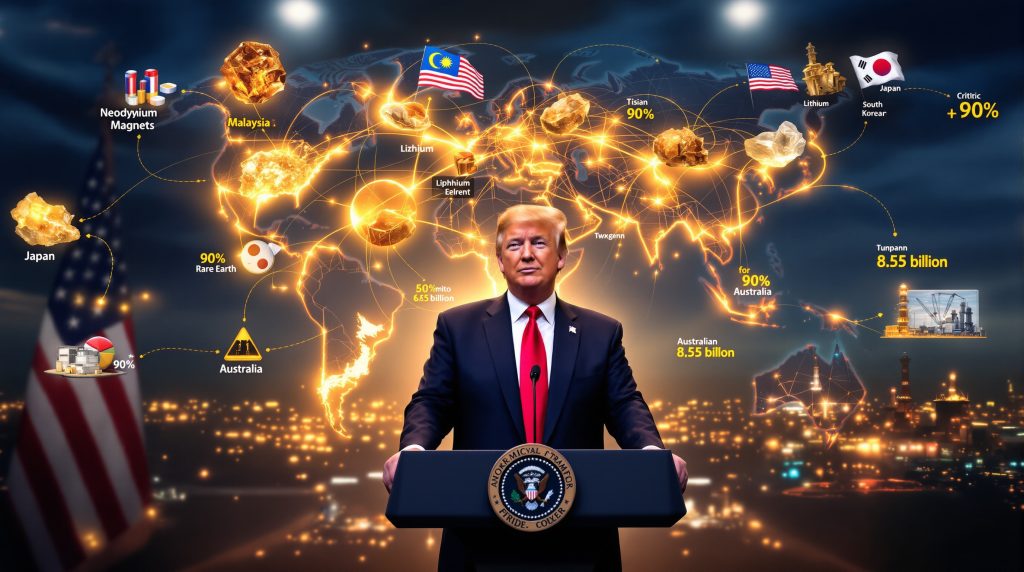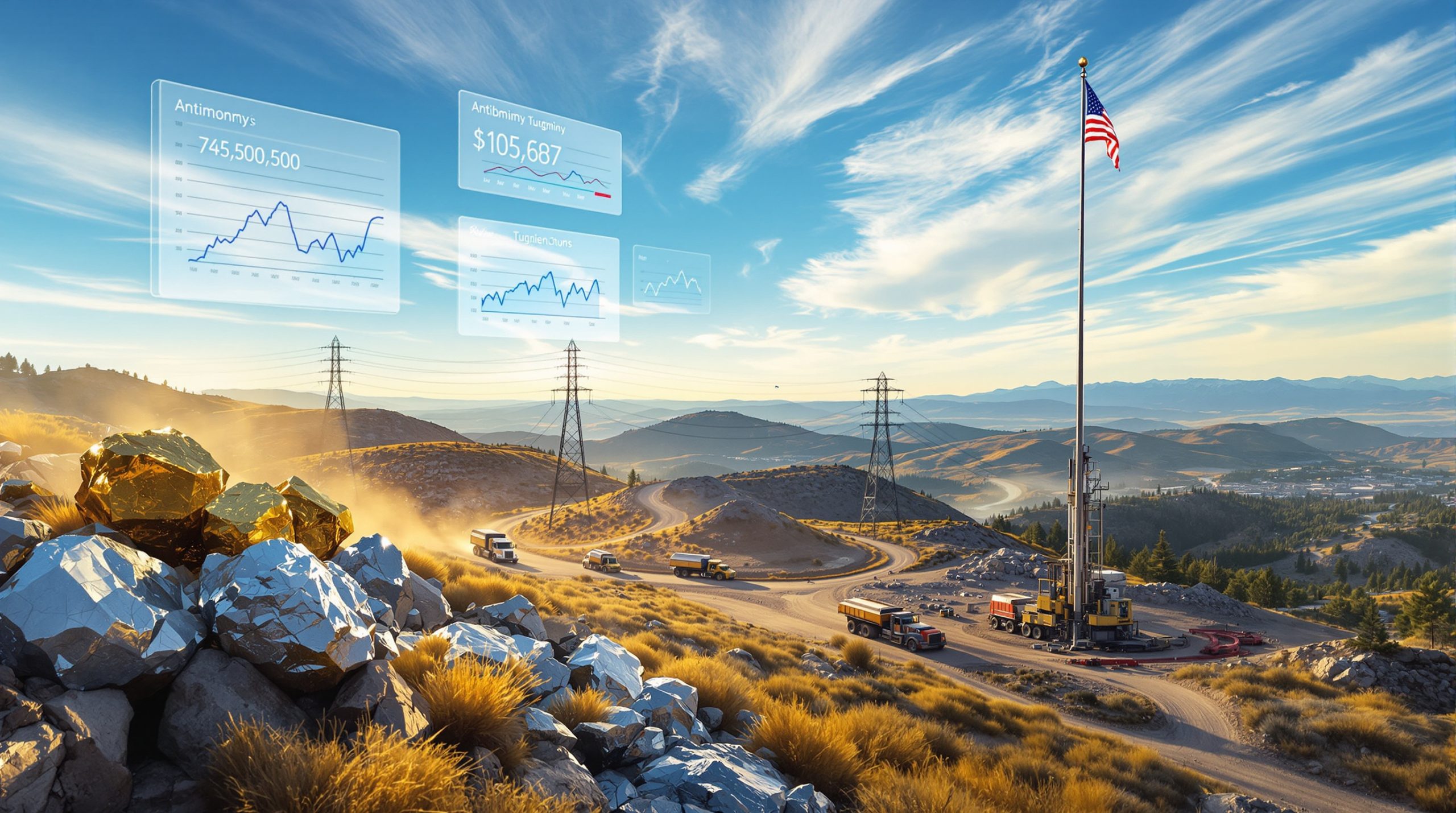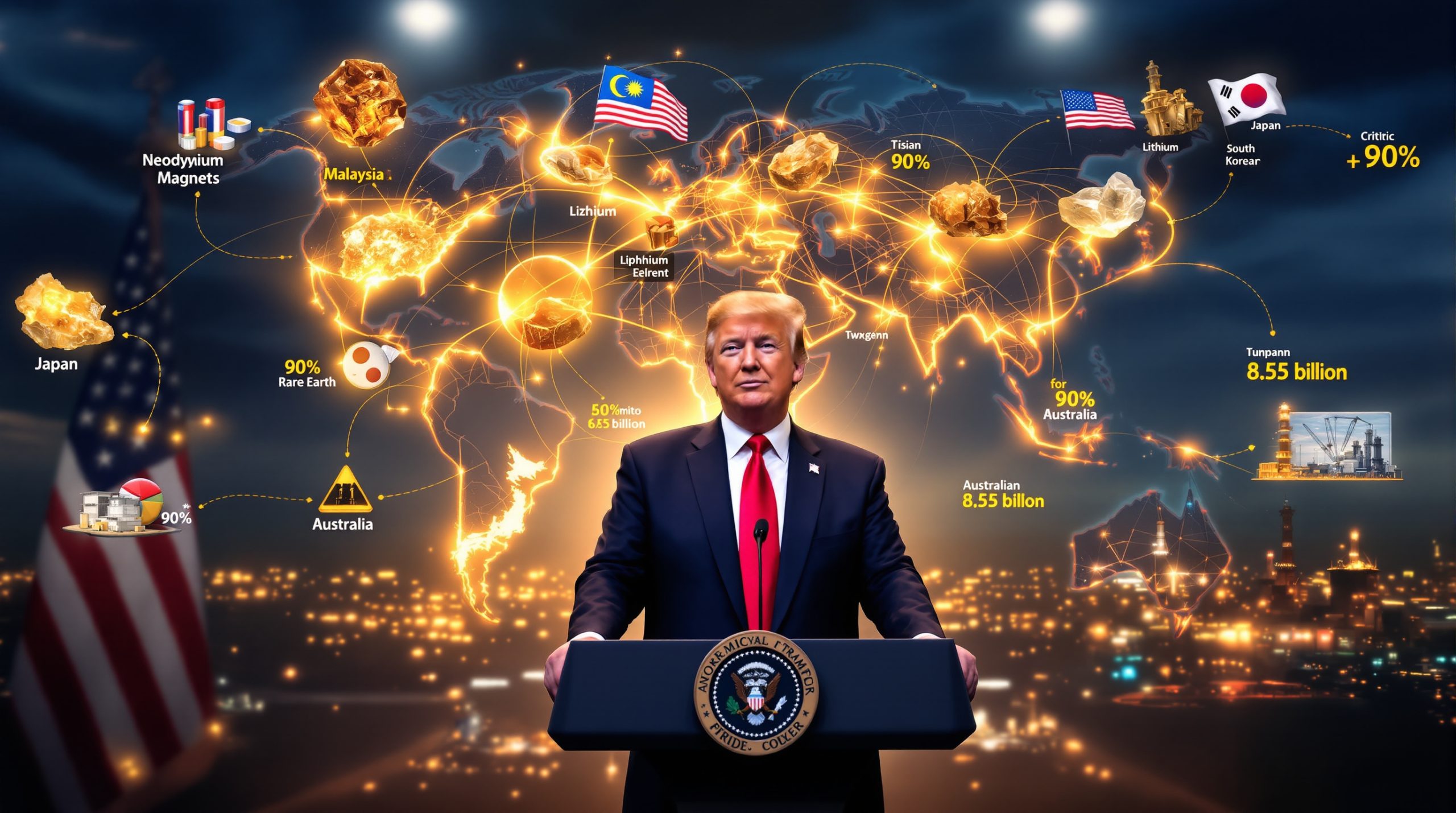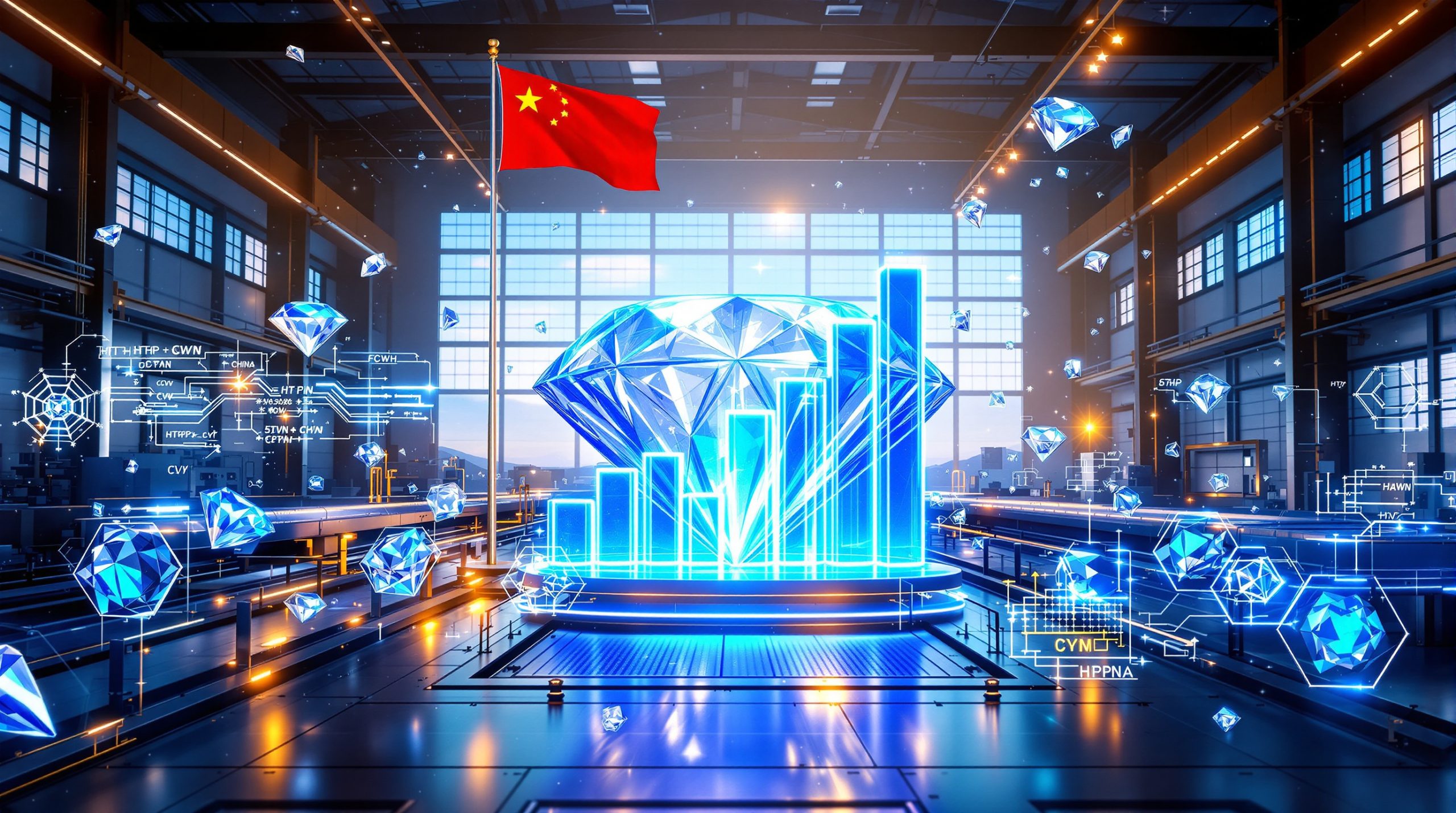Strategic Mineral Partnerships Reshape Asia-Pacific Resource Landscape
The Asia-Pacific region has become the focal point for a comprehensive restructuring of global critical mineral supply chains, as geopolitical tensions drive nations toward supply chain diversification. Trump to sign mineral deals in Asia represents a pivotal moment in this strategic realignment, involving unprecedented cooperation between multiple countries to establish alternative resource corridors that fundamentally challenge existing market dynamics dominated by single-source dependencies.
The initiative encompasses bilateral agreements spanning from Southeast Asia to advanced manufacturing economies, creating integrated networks designed to support modern technology sectors, defence systems, and renewable energy infrastructure. These partnerships represent more than traditional trade agreements, incorporating technology transfer, processing capabilities, and long-term strategic resource security frameworks.
Malaysia Emerges as Southeast Asia's Critical Mineral Gateway
Malaysia's position within this strategic framework reflects the country's unique combination of historical mining expertise, existing infrastructure, and geographic advantages. Investment, Trade and Industry Minister Zafrul Aziz has confirmed active discussions regarding comprehensive critical minerals cooperation, positioning Malaysia as a key alternative processing hub for regional supply chains.
The country's rare earth processing capabilities centre on the Lynas Corporation facility in Kuantan, Pahang, which represents Southeast Asia's only significant rare earth processing operation outside Chinese control. According to Lynas Corporation's 2023 Annual Report, this facility processed approximately 16,000 tonnes of rare earth oxides in fiscal year 2023, with expansion projects targeting 25,000 tonnes annual capacity by 2025.
Malaysia's tin industry, though substantially reduced from its historical peak of 63,000 tonnes in 1972, still maintains approximately 900 tonnes of annual production according to US Geological Survey data. This existing mining infrastructure provides foundational capabilities for expanding into other critical mineral processing operations, particularly given the country's established regulatory frameworks and skilled workforce.
Furthermore, the strategic significance extends beyond current production capacity to include Malaysia's potential role in regional supply chain coordination. The country's membership in ASEAN provides diplomatic advantages for broader Southeast Asian resource cooperation, while its established trade relationships with both Western and Asian markets offer flexibility in export destination planning.
Japan and South Korea Contribute Advanced Processing Technologies
Japan's involvement brings sophisticated separation and refining technologies essential for transforming raw materials into high-grade products suitable for advanced manufacturing applications. Japanese companies control approximately 1,500 patents related to rare earth processing and separation technologies as of 2020, according to Japan Oil, Gas and Metals National Corporation reports.
The technological advantages include advanced solvent extraction processes developed in the 1970s-1980s that improved separation efficiency by 40-60% compared to earlier methods. Research published in Hydrometallurgy documents how Japanese companies pioneered organophosphorus extractants that revolutionised rare earth element separation, creating competitive advantages that persist today.
In addition, Japan's strategic stockpiling approach, implemented following supply disruptions in 2010-2011, demonstrates the country's commitment to supply chain security. Japanese companies invested over $500 million in alternative rare earth sources between 2011-2020, establishing diversified supply relationships that complement the current partnership framework.
South Korea's contribution centres on battery manufacturing capabilities that represent approximately 30% of global lithium-ion battery production capacity. The combined annual capacity of LG Energy Solution (260 GWh), Samsung SDI (85 GWh), and SK On (110 GWh) totals 455 GWh, representing significant downstream demand for critical battery materials.
This manufacturing scale creates natural market pull for lithium, cobalt, nickel, and graphite supplies, providing economic justification for expanded mining and processing operations throughout the partnership network. However, the integration of upstream resource development with downstream manufacturing capacity reduces transportation costs and supply chain risks while creating economies of scale.
Australia's $8.5 Billion Foundation Demonstrates Partnership Potential
Australia's strategic reserve serves as a blueprint for subsequent partnerships, showcasing how bilateral cooperation can unlock substantial resource development opportunities. The country possesses 6.2 million tonnes of lithium resources, representing 51% of global reserves according to Geoscience Australia data.
Current Australian lithium production totals approximately 61,000 tonnes annually, making it the world's leading producer. This production capacity, combined with significant rare earth deposits including the Mount Weld project in Western Australia and the Nolans project in Northern Territory, provides substantial expansion potential within the partnership framework.
Australia's advantages extend beyond resource endowments to include established mining expertise, transparent regulatory frameworks, and political stability factors that reduce supply chain risk premiums. Dr. Daniel Franks from the University of Queensland's Sustainable Minerals Institute notes in Resources Policy research that these institutional advantages significantly enhance Australia's attractiveness as a strategic resource partner.
Consequently, the development timelines for Australian projects typically require 2-4 years from final investment decision to production for lithium projects, with rare earth projects averaging 3-5 years. Processing facilities add 18-24 months to development schedules, suggesting realistic production increases could begin within 2-3 years under accelerated development programmes.
Challenging China's Comprehensive Resource Control
China's dominance across critical mineral supply chains extends far beyond mining operations to encompass processing, refining, and manufacturing capabilities. The country controls approximately 70% of rare earth mine production and 85-90% of processing capacity, creating multiple chokepoints within global supply networks.
The scope of Chinese control becomes apparent when examining specific materials:
• Rare earth elements: 210,000 tonnes annual production (70% of global total)
• Lithium processing: Significant refining capacity despite limited domestic resources
• Graphite production: 79% of global natural graphite supply
• Permanent magnets: Over 90% of global production capacity
• Battery materials processing: Dominant positions in cathode and anode material production
Recent Chinese export controls have systematically targeted strategic materials, beginning with rare earth technologies in December 2020, expanding to gallium and germanium in July 2023, and including graphite restrictions in October 2023. These measures demonstrate how resource control translates into geopolitical leverage, as reported by Reuters.
The technical challenges of establishing alternative processing capabilities cannot be understated. Research published in JOM: The Journal of The Minerals, Metals & Materials Society explains that rare earth separation requires multi-stage solvent extraction processes involving hundreds of individual extraction stages. Building this infrastructure requires $500 million to $1 billion per facility and 3-5 years of process optimisation.
Targeted Strategic Materials Drive Partnership Focus
The partnership framework prioritises specific materials based on supply vulnerability, strategic importance, and demand growth projections. For instance, rare earth elements receive primary attention due to their irreplaceable roles in advanced technologies and defence systems.
Neodymium demand projections illustrate the scale of required supply chain expansion. Each electric vehicle requires 1-2 kg of neodymium for traction motors, while each 3 MW wind turbine requires approximately 600 kg. The International Energy Agency projects global neodymium demand increasing from 31,000 tonnes in 2020 to 94,000 tonnes by 2030.
Dysprosium applications focus on high-temperature magnet performance essential for electric vehicle and wind turbine operations. Research in Journal of Cleaner Production documents how dysprosium additions of 6-10% by weight significantly improve magnet performance at elevated temperatures of 150-200°C, critical for variable load applications.
Furthermore, battery material requirements reflect the automotive industry's electrification timeline. Lithium demand for batteries represents 74% of total consumption, with global production totaling 130,000 tonnes in 2022. Each electric vehicle battery (60-100 kWh capacity) contains approximately 5-15 kg of cobalt and 50-100 kg of graphite, depending on battery chemistry specifications.
Why Are Defense-Critical Materials a Priority?
Defence-critical materials include tungsten for armour-piercing ammunition and aerospace components, with China producing approximately 83,000 tonnes annually (69% of global production). Germanium's unique optical properties make it irreplaceable in forward-looking infrared systems and night vision devices, while gallium enables advanced semiconductor applications in 5G infrastructure and radar systems.
These materials have become increasingly important as nations recognise the vulnerability of depending on single suppliers for defence applications. The partnership approach aims to establish multiple supply sources to reduce strategic risks.
Supply Chain Transformation Through Geographic Diversification
The partnership approach creates multiple processing nodes across different jurisdictions, reducing single-point-of-failure risks while enabling specialised capabilities development. Each participating country contributes distinct advantages to the integrated supply network.
| Country | Primary Contribution | Development Timeline | Annual Capacity Potential |
|---|---|---|---|
| Malaysia | Rare earth processing | 18-24 months | 25,000 tonnes REO |
| Australia | Mining and concentration | 12-18 months | 80,000+ tonnes lithium |
| Japan | Advanced separation technology | 6-12 months | Technology licensing |
| South Korea | Battery manufacturing | 12-18 months | 500+ GWh capacity |
The geographic distribution strategy addresses multiple risk factors simultaneously. Political stability differences across countries reduce the likelihood of coordinated supply disruptions, while regulatory diversity prevents single regulatory frameworks from affecting entire supply chains.
However, transportation infrastructure requirements vary significantly by location and material type. Rare earth concentrates require specialised handling due to radioactivity concerns, while lithium transport involves different safety protocols. The partnership framework must accommodate these technical requirements while maintaining cost competitiveness.
Economic Transformation Through Alternative Supply Networks
Price volatility reduction represents a primary economic benefit of supply diversification. Historical data demonstrates extreme price swings in rare earth markets, with neodymium oxide ranging from $35-145 per kg (314% variation) and dysprosium oxide fluctuating between $220-850 per kg (286% variation) during 2020-2023.
Lithium markets experienced even more dramatic volatility, with battery-grade lithium carbonate prices in China ranging from $6,500/tonne in January 2021 to a peak of $78,000/tonne in November 2022, before declining to $13,000/tonne by December 2023. This 1,100% volatility range over three years illustrates the risks of concentrated supply chains.
Research in Resources Policy explains that rare earth markets lack transparent spot markets and standardised pricing benchmarks, with approximately 70-80% of transactions occurring through long-term contracts linked to Chinese domestic prices. This pricing structure creates information asymmetry and limits price discovery mechanisms.
Investment requirements for alternative supply chain development reflect the capital-intensive nature of mining and processing operations. According to Resources Policy research on capital intensity trends:
• Hard rock lithium projects: $400-800 million average capital cost
• Rare earth mining projects: $500 million – $1.5 billion depending on scale
• Processing facilities: $300-700 million for separation and refining infrastructure
The International Energy Agency reports that global investment in critical mineral projects reached $135 billion in 2022, with battery supply chain investments totalling $95 billion (70% of total). This investment scale demonstrates both the opportunities and capital requirements associated with supply chain restructuring.
Technical Challenges and Implementation Realities
Professor Simon Jowitt from the University of Nevada, Las Vegas, published research highlighting significant economic challenges facing alternative rare earth supply chains. Chinese integrated operations benefit from decades of process optimisation, economies of scale, and co-located refining capacity, creating cost advantages that new operations typically cannot match initially.
New operations outside China typically face 30-50% higher operating costs during initial production years, according to Natural Resources Research analysis. These cost differentials reflect multiple factors including:
• Process optimisation requirements: 2-4 years to achieve design efficiency levels
• Skilled workforce development: Specialised training for rare earth separation processes
• Environmental compliance costs: Stricter standards in Western jurisdictions
• Scale disadvantages: Smaller initial production volumes compared to established Chinese facilities
Environmental permitting represents another significant timeline factor. Rare earth processing generates radioactive waste streams requiring specialised disposal facilities, while lithium extraction can impact local water resources. These environmental considerations extend project development timelines and increase capital requirements.
Consequently, the technical complexity of rare earth separation cannot be replicated quickly. Each element requires specific extraction conditions, with some processes requiring hundreds of individual separation stages. Building this expertise requires extensive technical knowledge transfer and years of operational experience.
Defence and Energy Security Implications
The partnership framework directly addresses national security vulnerabilities created by supply chain concentration. Each advanced fighter aircraft contains approximately 300-400 gallium-based electronic components, while military radar systems depend on rare earth permanent magnets that cannot be practically substituted with alternative materials.
Renewable energy deployment timelines directly correlate with critical mineral availability. Wind turbines require substantial rare earth content, with each 3 MW turbine containing approximately 600 kg of neodymium and 200 kg of dysprosium. Solar panel manufacturing depends on silver for electrical contacts and various semiconductor materials for photovoltaic cells.
Energy storage systems present perhaps the greatest material intensity challenges. Utility-scale battery installations require enormous quantities of lithium, cobalt, nickel, and graphite. A 100 MWh storage facility typically contains 15-25 tonnes of lithium, 8-12 tonnes of cobalt, and 60-100 tonnes of graphite, depending on battery chemistry.
The electric vehicle transition multiplies these requirements exponentially. Global EV sales projections suggest 30-50 million units annually by 2030, with each vehicle requiring 40-80 kg of lithium, 5-15 kg of cobalt, and 50-100 kg of graphite for battery systems.
How Will Energy Transition Demands Impact Supply Chains?
Energy transition minerals demand will continue growing exponentially as countries accelerate renewable energy deployment. This creates both opportunities and challenges for the new partnership framework, requiring careful coordination between supply development and demand growth.
The establishment of a battery-grade lithium refinery capacity across the region will be crucial for meeting these demands while reducing dependence on Chinese processing facilities.
Market Psychology and Investment Positioning
The announcement that Trump to sign mineral deals in Asia typically generates immediate market reactions across resource equity markets, with companies possessing assets in partner countries experiencing share price appreciation. However, the long-term value creation depends on successful project execution rather than initial market enthusiasm.
Investors should consider several factors when evaluating opportunities within the partnership framework:
Asset Quality Assessment:
• Resource grade and tonnage: Higher-grade deposits offer better economics
• Metallurgical characteristics: Some resources require complex processing
• Infrastructure proximity: Access to ports, power, and transportation
• Regulatory environment: Permitting timelines and political stability
Technical Risk Evaluation:
• Processing technology availability: Rare earth separation expertise remains limited
• Environmental compliance requirements: Waste management and water usage
• Skilled workforce availability: Specialised technical expertise requirements
• Capital intensity: Multi-billion dollar facility requirements
Market Positioning Strategies:
• Diversified geographic exposure: Multiple jurisdictions reduce political risk
• Integrated supply chain participation: Mining through processing to manufacturing
• Long-term contract security: Stable revenue streams during price volatility
• Technology partnership development: Access to advanced processing capabilities
This represents a significant critical minerals pivot in how nations approach resource security and supply chain resilience. The success of these initiatives will largely depend on execution capabilities and sustained political support across multiple jurisdictions.
Future Outlook and Strategic Implications
The success of these mineral partnerships will significantly influence global resource geopolitics over the next decade. Successful diversification could reduce Chinese leverage in trade negotiations while creating new centres of resource processing expertise across the Asia-Pacific region.
However, the timeline for achieving meaningful supply chain alternatives remains challenging. Industry analysis suggests 5-7 years for establishing fully operational alternative supply chains, including mine development, processing facility construction, and workforce training. This timeline assumes favourable regulatory environments and adequate capital availability.
The competitive response from existing suppliers may include price competition, supply guarantee offers, or accelerated technology development programmes. These market dynamics will influence the economic viability of alternative supply chain investments and require careful monitoring by project developers.
Environmental and social governance considerations will play increasingly important roles in project development success. Communities and governments expect higher environmental standards and greater local economic benefits compared to historical mining operations, potentially extending development timelines but creating more sustainable long-term operations.
Understanding global cobalt reserves distribution will also be crucial for partnership success, as cobalt remains a critical component in many battery technologies despite efforts to reduce dependence through chemistry innovations.
As Trump to sign mineral deals in Asia moves forward, the implications extend beyond simple trade agreements to encompass fundamental shifts in how nations approach resource security and technological independence. The coming months will be critical in determining whether these ambitious partnerships can deliver on their promise of creating viable alternatives to existing supply chain structures.
Furthermore, Politico's analysis suggests these deals represent broader strategic realignments in Asian trade relationships, with Trump to sign mineral deals in Asia serving as a cornerstone for expanded economic cooperation across the region.
Investment Disclaimer: The mineral resources sector involves significant risks including commodity price volatility, regulatory changes, technical challenges, and geopolitical factors. Projected timelines and production targets represent estimates that may not be achieved due to various operational and market factors. Investors should conduct thorough due diligence and consider professional advice before making investment decisions in critical mineral projects or related securities.
Ready to Capitalise on Asia-Pacific Mining Opportunities?
Discovery Alert's proprietary Discovery IQ model delivers instant alerts on significant ASX mineral discoveries, empowering subscribers to identify actionable opportunities in the rapidly evolving critical minerals sector before the broader market responds. Explore why major mineral discoveries can generate exceptional returns and begin your 30-day free trial today to position yourself ahead of these transformative market developments.




